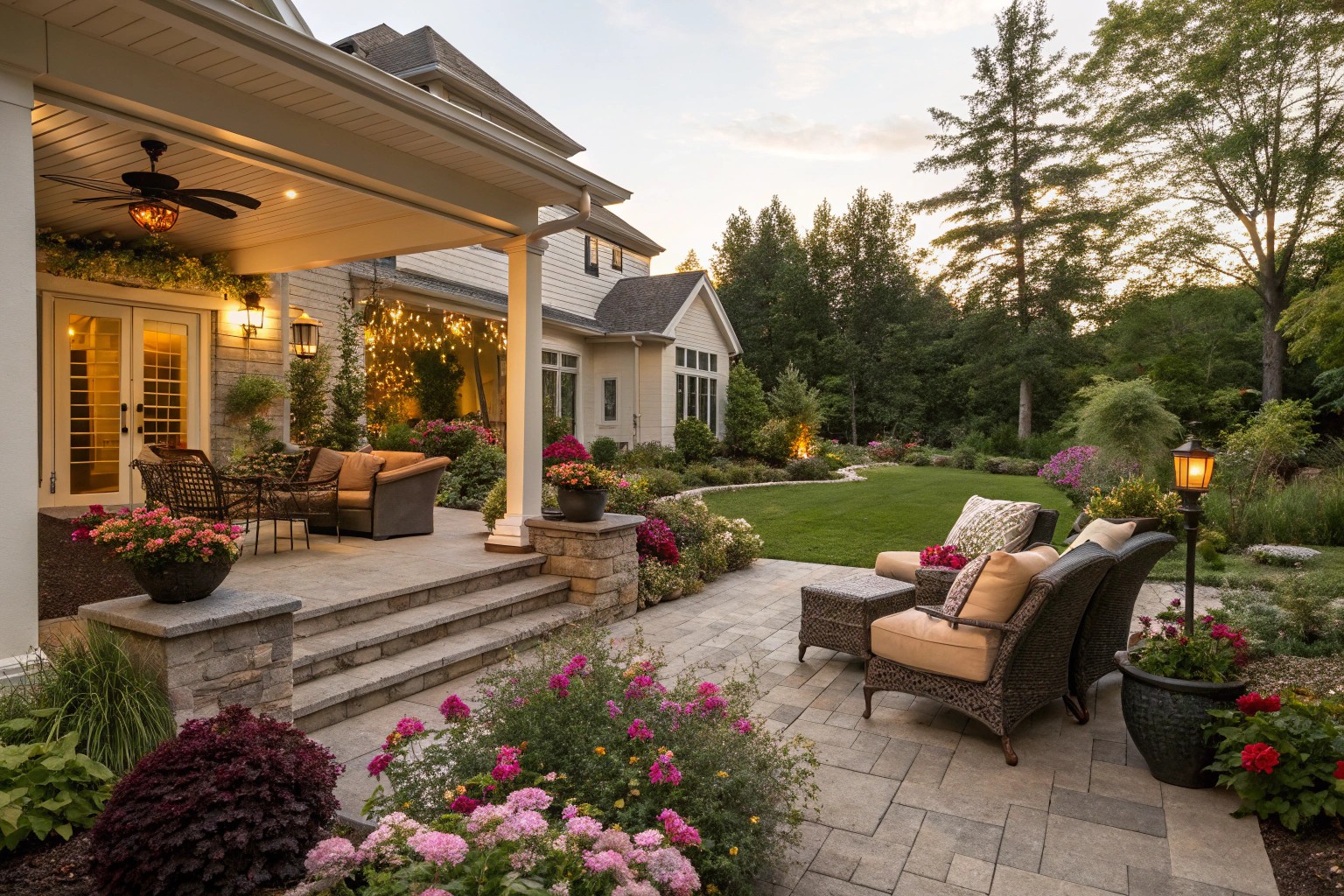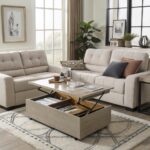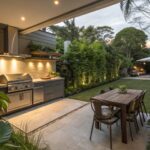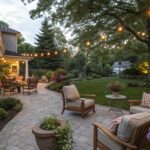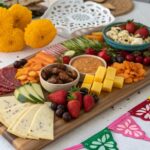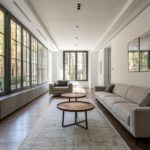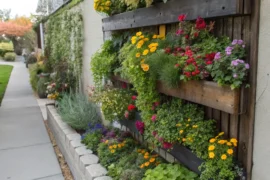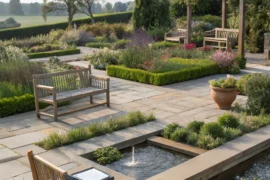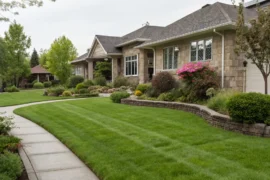After designing outdoor spaces for over a decade, I’ve noticed one consistent pattern: many beautiful patios sit unused for half the year. The difference between a showpiece and a well-loved outdoor space often comes down to thoughtful planning for seasonal transitions. This guide will walk you through creating a truly functional patio that serves your lifestyle through every season of the American climate.
Understanding Seasonal Transitions

The most successful year-round patios anticipate how the space needs to function differently as seasons change. When I work with clients in variable climates, we start by mapping out seasonal challenges and opportunities.
Climate Considerations by Season
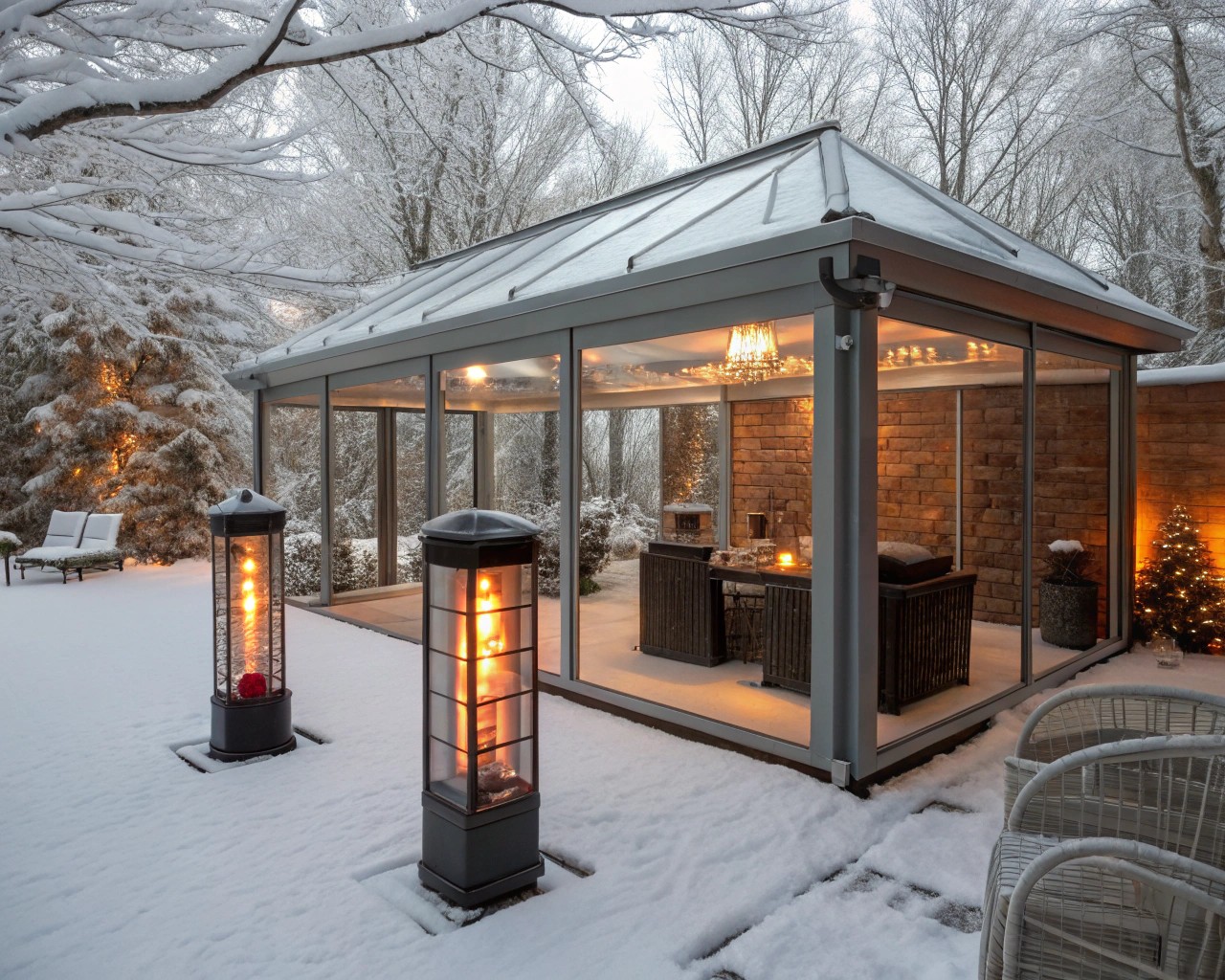
Each season presents unique challenges for outdoor living:
Spring: Focus on moisture management and variable temperatures. In Salt Lake City, where spring weather can change rapidly, I recommend flexible features like retractable screens that can adapt quickly.
Summer: Prioritize shade solutions and cooling elements. When redesigning a client’s backyard in Phoenix, we created a courtyard-style space that established a microclimate to moderate extreme temperatures.
Fall: Introduce warmth through fire features and cozy textiles. Think of adding throws in rich, autumnal colors — burnt orange, deep red, and mustard yellow.
Winter: Implement weather protection and reliable heat sources. An enclosed patio with solid roofing dramatically extends usability in colder months.
Seasonal Elements Table
| Season | Primary Challenges | Essential Elements | Bonus Features |
|---|---|---|---|
| Spring | Unpredictable weather, Rain | Covered seating, Proper drainage | Spring-blooming containers, Retractable covers |
| Summer | Heat, Sun exposure | Shade structures, Cooling solutions | Outdoor kitchen, Water features |
| Fall | Dropping temperatures, Leaf debris | Fire features, Wind protection | Warm lighting, Weather-resistant cushions |
| Winter | Cold, Precipitation | Enclosure options, Heating elements | Insulated flooring, Weatherproof storage |
Essential Elements for Year-Round Use
Shelter and Coverage Options
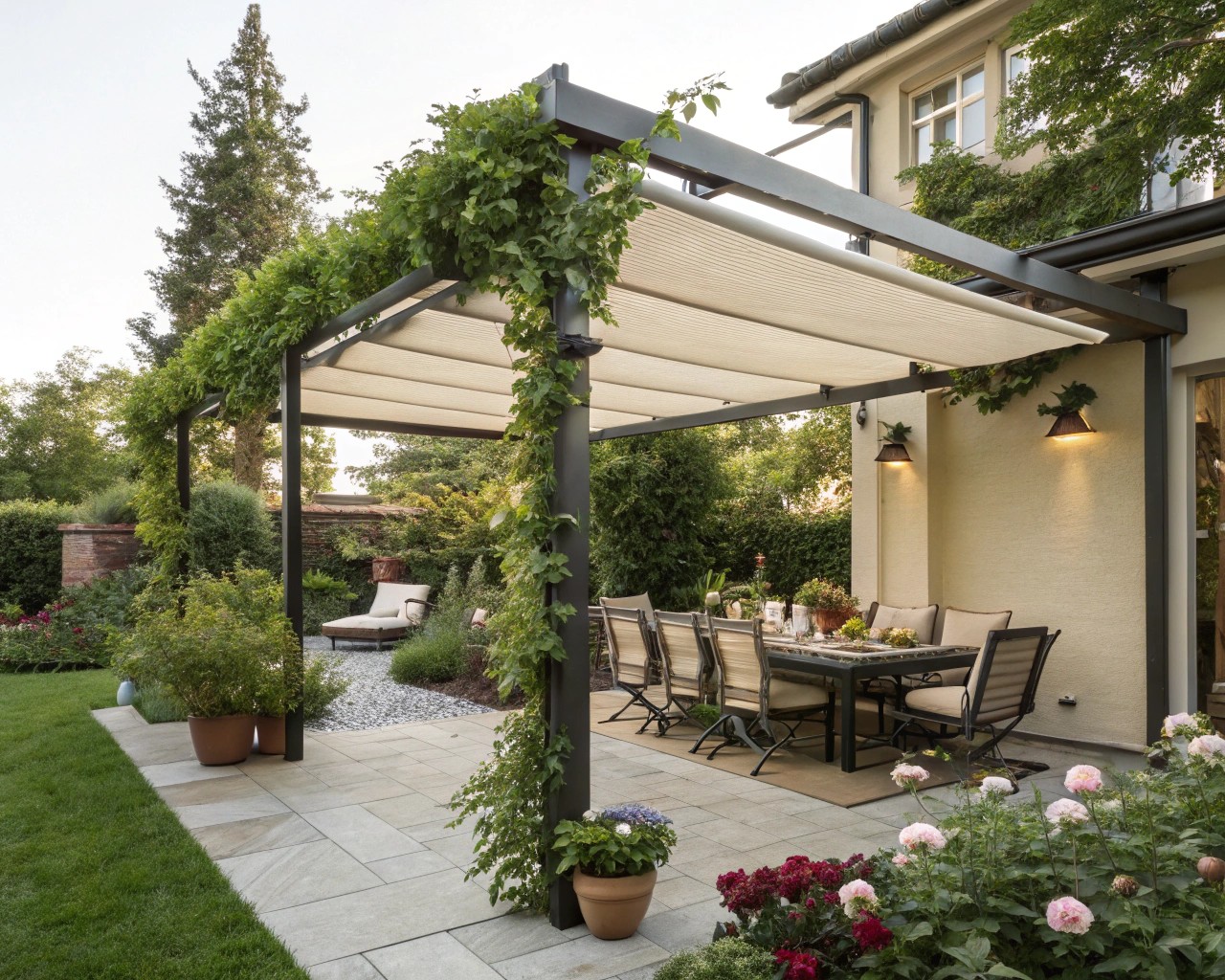
The foundation of any year-round patio is appropriate shelter. Based on client feedback and professional experience, these are the most effective options:
-
Pergolas with retractable canopies: These provide flexible protection from both sun and rain. One restaurant client reported a 30% revenue increase after adding a pergola with a retractable canopy to their outdoor dining area.
-
Covered patios: Fixed roofing provides reliable protection. For a family in Tarrytown, we integrated a cabana structure that offered shade while creating a clear spatial “bookend” to their pool area.
-
Enclosed patios: For maximum year-round use, partial or full enclosure dramatically extends usability. A recent industry report highlights enclosed patios as an excellent solution for year-round garden enjoyment, providing protection, comfort, and aesthetic value.
Heating and Cooling Solutions
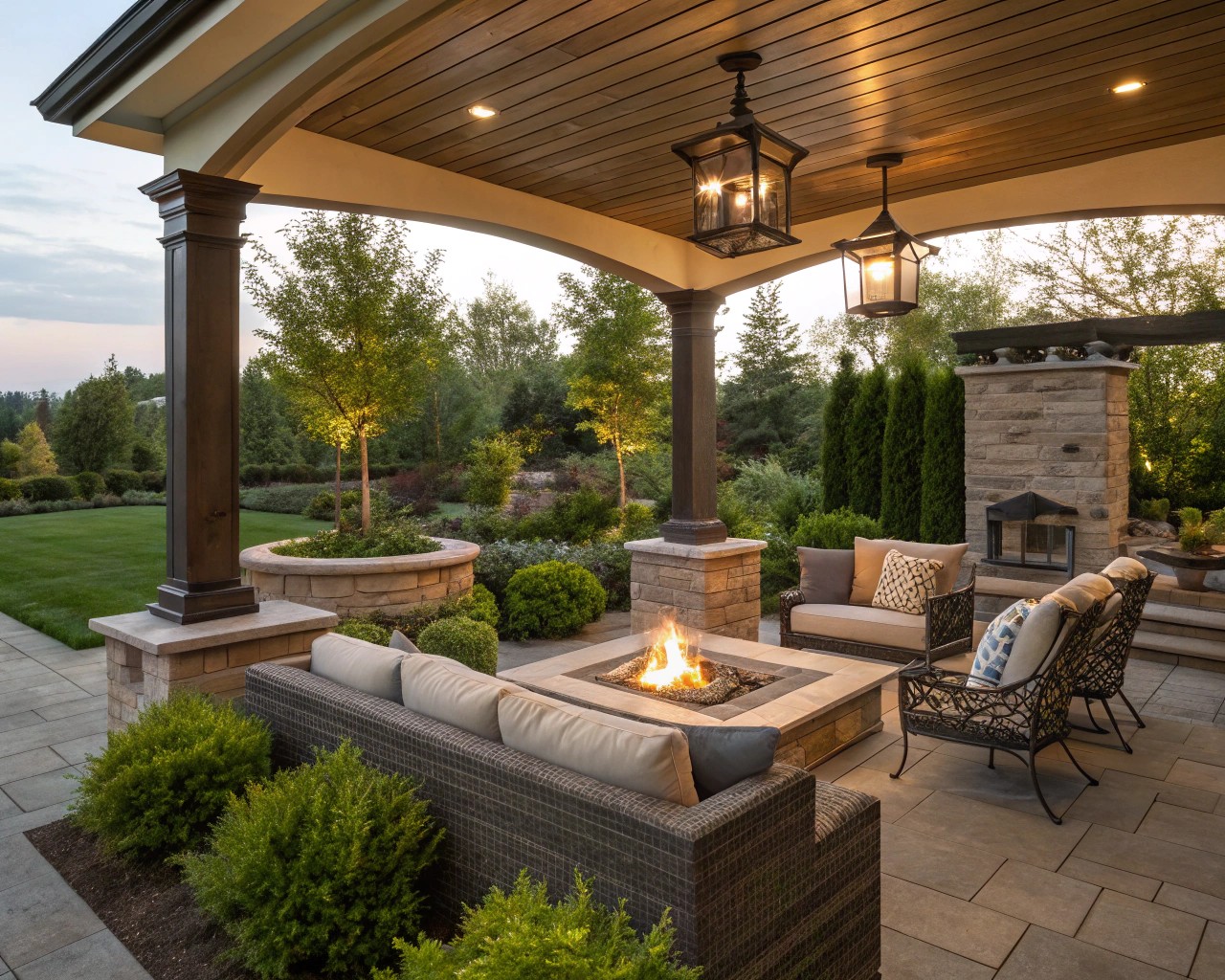
Temperature control is critical for extending patio seasons:
For Warmth:
- Built-in fire pits or fireplaces
- Overhead infrared heaters
- Portable propane heaters
- Radiant floor heating (for premium installations)
For Cooling:
- Ceiling fans under covered areas
- Misting systems for dry climates
- Strategic planting for natural shade
- Water features for evaporative cooling
In a recent Evanston project, we designed a circular fire pit area made of bluestone, surrounded by natural stone outcroppings. These stones served both to retain the grade and offer extra seating for guests. This feature not only provided warmth but also created a natural gathering spot that clients enjoy well into the fall.
Lighting for Extended Hours
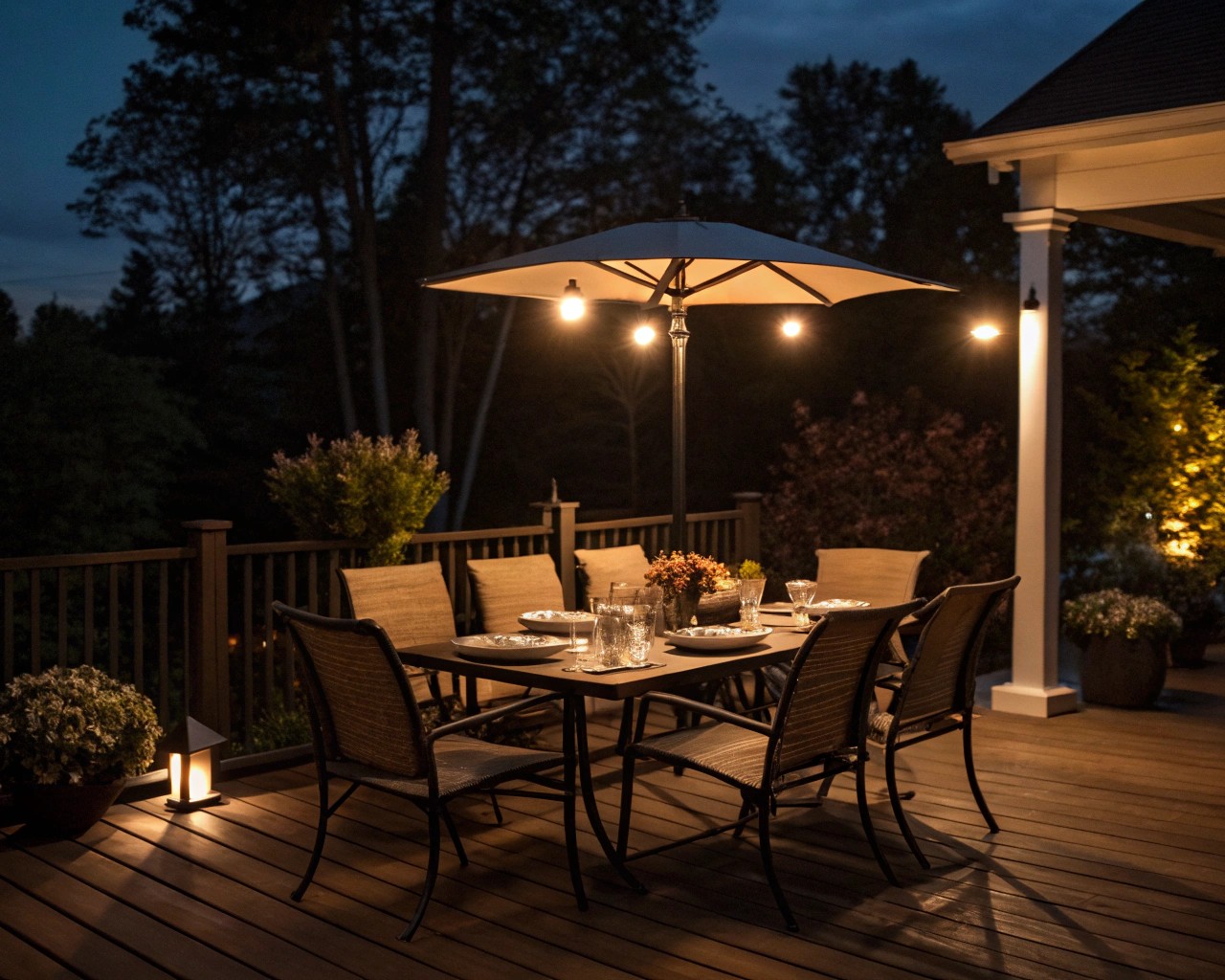
I’ve found that proper lighting extends patio use into evening hours regardless of season:
- String lights or fairy lights for ambient illumination
- Path lighting for safety and navigation
- Task lighting near cooking and dining areas
- Accent lighting to highlight architectural features
When working with restaurant owners, we’ve seen that string lights are particularly effective at creating a “cozy vibe as the sun sets”. For residential clients, outdoor chandeliers under pergolas elevate the space and encourage lingering after dark.
Maximizing Layout Functionality
Creating Activity Zones
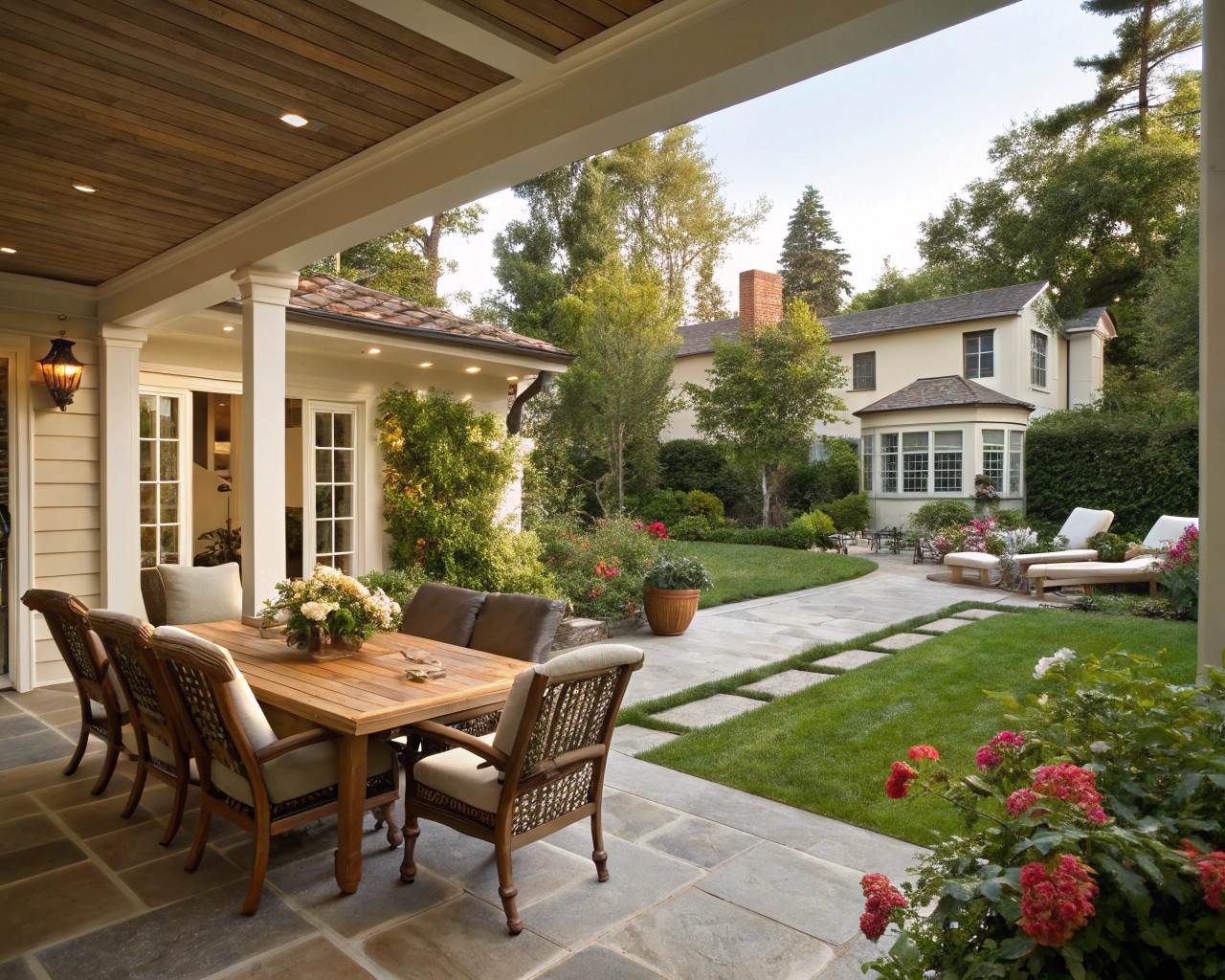
The most-used patios incorporate distinct zones for different activities. For instance, when designing a backyard for a client with a Victorian home, we established several purposeful areas, including a spacious deck for lounging, a dedicated kitchen and dining zone, a cozy fire pit area, and ample lawn space for their child to play.
Consider these zones in your planning:
- Dining area: Position near the kitchen door for convenient serving
- Conversation area: Center around a fire feature for year-round comfort
- Relaxation zone: Create a sheltered nook with comfortable seating
- Cooking station: Include a grill or outdoor kitchen where smoke won’t disturb seating
Space Optimization Techniques
When working with limited space, consider these strategies:
- Use linear designs rather than curved edges to maximize usable area
- Incorporate built-in seating along walls or borders
- Choose furniture that can be easily reconfigured
- Install vertical elements like living walls or privacy screens that don’t consume floor space
In a Haymarket, VA project, our focus was on implementing a linear design. This approach aimed to maximize the hardscaped area for the homeowners, moving away from typical curved-edge layouts which often reduce usable square footage.
Connecting to Interior Spaces
A strong indoor-outdoor connection significantly increases how often a patio gets used. Consider these approaches:
- Position the patio adjacent to frequently used interior rooms
- Align outdoor living zones with their indoor counterparts (dining area near dining room)
- Echo interior design elements in outdoor spaces for visual continuity
We recently designed a backyard for the “Slim House” project. Here, the pool featured varying depths specifically designed to encourage dynamic use at both ends, intentionally relating to the home’s interior layout. This thoughtful connection between inside and outside spaces created a cohesive experience that the family uses daily.
Case Studies: Successful Year-Round Patios
Desert Oasis: Microclimate Creation
The O-asis House in Phoenix tackles extreme heat with temperatures frequently exceeding 100°F:
- Created an O-shaped house with a central courtyard measuring 18 by 58 feet
- The courtyard design established a “mini micro-climate inside the house”
- White stucco exterior with a low 12.5-foot height helped the structure visually disappear into the desert landscape
- Solar power provided sustainable energy
The architect explained that creating the courtyard helps establish a more temperate “mini micro-climate” within the property’s boundaries. This approach gives the homeowners a protected outdoor space that moderates the extreme desert climate while providing privacy from neighbors.
Four-Season Entertainment Hub
A Northern Virginia project transformed a standard backyard into a year-round entertainment destination:
- Installed a large bluestone patio with a fiberglass pergola
- Created an outdoor kitchen with built-in grill, side burner, and wine cooler
- Added a basalt column water feature as a focal point
- Incorporated a circular fire pit area surrounded by stone outcroppings
- Used strategic planting for privacy and aesthetic appeal
The clients report using this space nearly every day of the year, with the pergola providing summer shade and the fire pit extending use well into winter.
Small Space Transformation
A modest enclosed patio near American University proves that size doesn’t limit year-round functionality:
- Removed existing brick patio surface
- Installed blue flagstone with cement between stones for a modern, level appearance
- Maintained modest dimensions (15 by 11 feet) while maximizing functionality
- Created proper drainage through careful grading
The client reported: “We are so happy with the results of our remodeled patio. Everyone was so professional and responsive from start to finish. They did a really great job making sure everything was exactly right. It has transformed our outdoor space”.
Material Selection for Durability
Flooring Options for Year-Round Use
Your patio flooring must withstand whatever Mother Nature throws at it. These materials have proven their durability in my projects:
| Material | Climate Suitability | Maintenance Level | Relative Cost | Notes |
|---|---|---|---|---|
| Bluestone | All climates | Low-Medium | High | Excellent freeze-thaw resistance |
| Composite Decking | All climates | Very Low | Medium-High | Good for elevated areas |
| Concrete Pavers | All climates | Low | Low-Medium | Many design options available |
| Porcelain Tile | Mild to moderate | Low | Medium-High | Look of stone with less maintenance |
| Brick | All climates | Medium | Medium | Classic look but may settle over time |
Furniture Selection Strategy
Investing in the right furniture makes a significant difference in patio usability:
- Choose all-weather materials like teak, aluminum, or resin wicker
- Select furniture that can be easily moved or reconfigured
- Consider storage options for cushions during extreme weather
- Look for quick-drying fabrics and materials
I often advise clients that selecting furniture intended to stay outdoors year-round requires the same care as choosing indoor pieces. Consider it an investment in your lifestyle, rather than mere decoration.
Implementation and Maintenance
Phased Approach to Creation
Not everyone can complete a comprehensive patio transformation at once. Consider this staged approach that I’ve used successfully with many clients:
Phase 1: Create the foundational hardscape with proper drainage and layout
Phase 2: Add primary shelter elements like pergolas or covered areas
Phase 3: Incorporate heating and lighting systems
Phase 4: Finish with furniture, plantings, and aesthetic elements
This approach allows you to spread costs while maintaining a cohesive final design. Many of my clients complete their dream patios over 2-3 years while enjoying improvements along the way.
Seasonal Maintenance Checklist
To keep your patio functional year-round, establish these maintenance routines:
Spring Tasks:
- Clean drainage systems
- Inspect structures for winter damage
- Apply sealants or protective treatments
- Refresh planting areas
Summer Tasks:
- Check irrigation systems
- Clean and maintain shade structures
- Inspect outdoor furniture
- Trim vegetation around the patio
Fall Tasks:
- Clear gutters and drainage paths
- Protect sensitive plants
- Store or cover seasonal furniture
- Prepare heating elements
Winter Tasks:
- Remove snow promptly from structures
- Check for ice damage
- Maintain heating systems
- Protect plumbing from freezing

